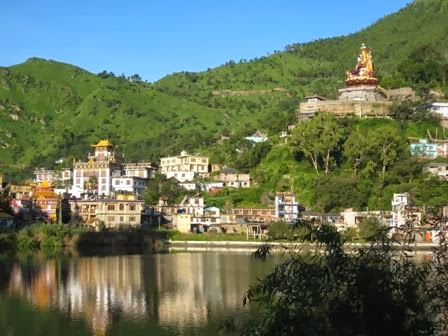 |
| Tulku Pema Wangyal, Seattle 1976. |
Somewhere on the huge railroad system that covers India lies Bolpur, a small town in Birbhum district of West Bengal. It has a transit station, a place where no one seems to live. Travelers come there mainly to switch trains to and from Shantiniketan, the famous international university founded by Nobel Laureate Rabindranath Tagore where cultures of the East and West meet and mingle. The million people who had passed through had a million aims. Mine is to learn Tibetan.
Tulku Pema Wangyal has sent me to seek the admission at the Tibetan department which is under the care of C.R. Lama, a tantric master disguised as professor. His divinations have been a tossup between Tulku Thondup in Lucknow and this university. Success in either looked like reading the meter of Erik’s lack of merit, if I was allowed to divine Tulku Pema’s face, but this was the lesser of two evils. Before departure, he hands me The Golden Garland Chronicles, Padmasambhava’s detailed biography. “Perhaps one day you can translate this into English.” The book is seven hundred and sixty five pages and I can barely read.
I reach the train station at night. It seems quiet, if you discount the loud clicking and clacking of the electric bulbs, as if hit by small objects. An undulating carpet covers everywhere, and crunches with every step you take. Now I see it is made of a sea of dead and dying mega-grasshoppers. They have all come to die together at this train station. Perhaps because it is the only place lit up brightly within a radius of thirty miles. Perhaps so they can see each other while they pass away from their grasshopper life.
A man wearing the official dark blue uniform uses a makeshift snow scraper, making corpse-free walkways, transporting blends of life-and-death over the side to the tracks, for rats to feast. I notice no particular expression on his face.
Under the corrugated iron roof there are benches and notice boards. I move over there, skipping from one tiny empty spot to the next. I hear the crunch of evil karma.
“Never mind,” a voice announces. “It happens like this every summer.”
On the notice board I see many hundreds of large photographs, close perhaps to one thousand. All are black-and-white, clearly defined, perfect focus. Each shows the face of a human being. Of all ages. There is writing beneath each, and some scribbles in Hindi. As I walk by them, I’m struck by the silence in their eyes. They have one more thing in common. Everyone has been photographed after death.
Each of these departed members of our human race must have posed lying down, with the photographer leaning close, right above, very intimate. In life they must have been too poor to have a name. And now their unclaimed faces are displayed in this gallery of masterful pictures, on a lonely railroad station near Shantineketan, where grasshoppers come to die under electric light on summer nights.
The silence I hear now is one I know. I’ve heard it many times before. When I stopped to listen on my way home from high school, with no plan in mind.
Soon my train arrives. I drink chai with roasted peanuts. Into the darkness vanishes Bolpur station, the place where no one seems to live.









